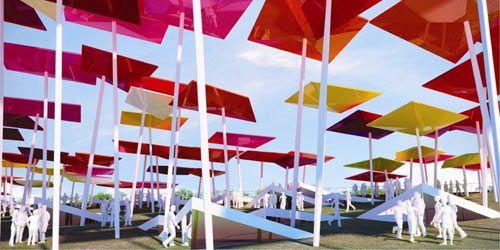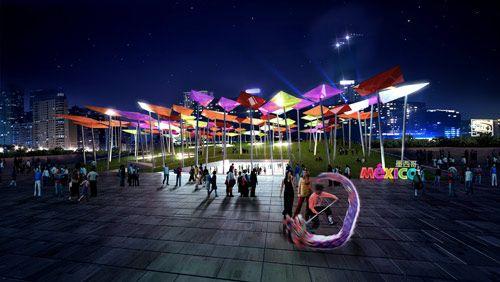Mexican Pavilion: under a green plaza and a kite forest
2010-01-05 15:47 BJTSpecial Report: Shanghai World Expo 2010 |
A green plaza under a sea of giant colorful kites flying in the sky held up by supporting poles
This is a picture of the Mexico Pavilion for the 2010 Shanghai World Expo, which was unveiled yesterday. The pavilion looks magnificent in the picture, but many people will undoubtedly ask: where is the Mexico Pavilion? A Mexican designer reveals the secret: the three-story exhibition hall is concealed under the green plaza. The Mexico Pavilion will be the only building whose main body is located underground at the 2010 Shanghai Expo. With kites flying over and an underground treasure house of exhibits, the Mexico Pavilion is creative and original.
 |
|
Mexican Pavilion for Shanghai World Expo 2010 |
|
|
|
Mexican Pavilion for Shanghai World Expo 2010 |
Why is the Mexico Pavilion worth visiting? Because the main body of the pavilion is below ground, the Mexicans have worked their brains to design an ingenious roof. The main building of Mexico Pavilion is on a big slope, but seen above ground it seems to be a small slope. The 4,000-square-meter sloped roof has been transformed into an open plaza. The green plaza, which is covered in grass, not only symbolizes open urban spaces, but also exemplifies the Mexican ideal of "recovering green areas in the city."
Looking up from the green slope, you will see a forest of kites. There will be 135 giants kites flying in the sky. Fixed onto poles, the kites will cover the entire Mexican Pavilion. There are five different colors of kites: purple, white, orange, red, and yellow, and are a colorful way to decorate to the sky over the Mexican Pavilion. While discussing the practical functionality of the kite forest, Eduardo Seldner, commissioner general of the Mexico Pavilion, said: "In the future, people can take shelter from the rain and sun under the kites."
Kites carry more profound implications. "Flying kites" is popular both in China and Mexico. In Spanish, the official language of Mexico, the word "kite" comes from Nahuatl, which was a common language among American tribes in the region, now known as Mexico, before the New World was discovered by Europeans. This shows that kites have a long history on the American Continent. Kites originate in China, so these kites "flying" above the Mexican Pavilion are a messenger of cultural exchange between China and Mexico. Mr. Selder depicts future scenes in the Mexico Pavilion: visitors can read a book, have a picnic or simply relax on the grass under the shade of the kites, while the kites, a symbol of freedom and dreams, fly in the sky.
Entering the first underground floor of the Mexico Pavilion from the main entrance, which faces the street, visitors will see more kites. They will be able to buy a kite from the pavilion, or even learn to make a kite by hand. Walking further downstairs and arriving on the third floor below ground, visitors will set out on a "Treasure Hunt." The numerous treasures in the Mexico Pavilion span various historical periods of Mexico, including the prehistoric era, colonial times, and the modern period. The most eye-catching will be the Mayan Ruins. Mexicans will bring Mayan snake-shaped decorations, totems, and locally preserved masks to the pavilion. In the vast expanse of Mexico, there are other world cultural heritage items as well as unique and abundant biotic resources. These things will all make their appearance in the pavilion. After completing this "Treasure Hunt," visitors will feel like they have traveled around the American Continent.
Translated by LOTO
Editor: Shi Taoyang | Source: CCTV.com
 Mail
Mail Share
Share Print
Print



 Video
Video









 2009 China Central Television. All Rights Reserved
2009 China Central Television. All Rights Reserved